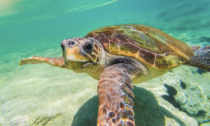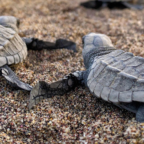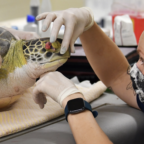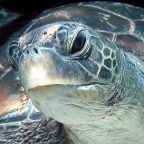
Nikoletta Sidiropoulou and her colleagues in the Sea Turtle Protection Society of Greece (Archelon) are huddled together on Marathonisi beach, carefully digging in the sand. Eventually they find what they’re looking for: a turtle nest, containing upwards of 100 eggs. “It’s really exciting,” says Sidiropoulou.
Endangered loggerhead sea turtles, or Caretta Caretta, make their main nesting spot on the Mediterranean island of Zakynthos – one of the most visited islands in Greece, with roughly 1 million yearly visitors, including many British tourists. Mass tourism has long threatened the loggerheads: tourists frequently break rules designed to keep them away from nests. But new research suggests the Covid-19 pandemic has allowed these turtles to come up for air.
The researchers found that loggerhead turtles changed their behaviour after the drastic reduction in visitor numbers and boats in 2020. In pre-pandemic years turtles in Laganas Bay usually moved from warmer waters 100m from the shore to deeper, colder waters, 400m away from the beaches, during their prime breeding season (May through June). But in 2020, the turtles stayed in the warmer waters “even when sea temperature reached the optimal temperatures elsewhere”.
The study, funded by the Queen Mary University of London and the Deakin University, Australia, suggests “increased tourism pressure, not temperature” was likely driving the turtles offshore, “potentially at the cost of [turtles] losing access to optimal thermal conditions that accelerate egg maturation and shorten inter-nesting intervals”.
In fact, 2020 was a record year for the number of nests found in Zakynthos. Archelon recorded 1,800 nests, the third-highest in the organisation’s 38 years on the island.
Proving a link between turtle behaviour and the drop in tourism during Covid is not straightforward. “It’s really hard to see what the exact impact [of tourism] is on the turtles. They’re forced to go out into deeper water, and [that] means they can lay fewer nests theoretically, but it’s really hard to prove that,” says Gail Schofield, a wildlife ecological researcher and one of the authors of the report.
However, Sidiropoulou adds: “Definitely it was easier for them to come out and nest because there were no obstacles for them out on the beaches during the night, like sunbeds, umbrellas or whatever might be [there] during the high-tourist season.”
The respite might be brief. Tourism is back in Zakynthos, particularly after the UK government eased quarantine restrictions on 19 July, and the island is again filled with partygoers and scores of motor boats in Laganas Bay.
The turtles’ breeding grounds are theoretically protected, as part of the Zakynthos national marine park, but violations of the rules are constant. According to Sidiropoulou boats illegally drop off dozens of tourists on the beach, where they are separated from the turtle nests only by a rope, and speedboats can often be found closely following a turtle swimming in the bay.
“Zakynthos has a lot of young tourists – most of them don’t even know turtles are nesting in the beach, so they are not familiar with the regulations either,” says Sidiropoulou.
Laurent Sourbes, coordinator of the Zakynthos national marine park, argues the only solution is fining rule-breakers, but more resources are needed.
“We are not able to do that on our own, we need the coastguard,” he says. However, with only one boat and thousands of tourists and vessels to monitor, the Zakynthos coastguard’s capacity is limited.
This week, the WWF found a dead turtle floating next to the island’s main port, apparently hit by a boat propeller, while earlier this summer two turtles were also killed by a boat strike.
“Now, the [government] is bringing two more boats for the coast guard but it’s a pity that you have to wait for turtles to be killed,” says Sourbes.
The head of the WWF Greece, Demetres Karavellas, says the issues in Zakynthos reflect a “broader challenge” regarding effective surveillance of protected marine areas in the country.
“It’s a big challenge, especially for a country [that is] also dealing with tourism. It’s obviously not a top priority,” Karavellas says.
Another beach on Zakynthos offers a model of how to proceed: Sekania beach has the highest density of loggerhead turtles in the Mediterranean, and is fully protected, with access prohibited to all visitors.
Sidiropoulou believes tourism and healthy ecosystems can coexist, and has argued to local authorities that a good first step would be to produce a study on the number of boats that Laganas Bay can withstand, though she does not expect the request to be agreed.
“Usually we don’t get an answer back, to tell you the truth,” she says. “Zakynthos is a beautiful island, but we want tourists to respect nature and to protect the species that have come here to lay their eggs for millions of years,” she says.















Social Profiles